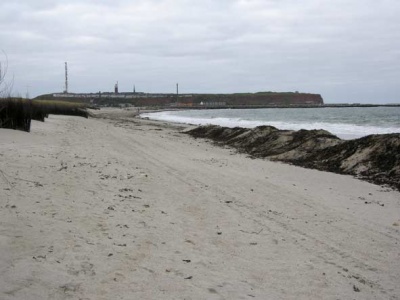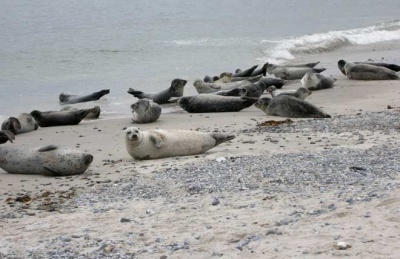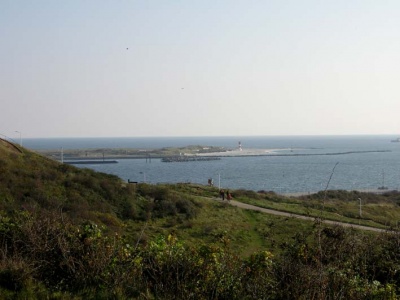Overview
Helgoland (or Heligoland) is a small archipelago, belonging to Germany and located in the German Bight area of the North Sea. It is 46 kilometres (29 miles) off the German coast and consists of two islands, the main one (sometimes called Hauptinsel), with the village and a small harbour, and the smaller, sandy island, Düne, a short distance to the east, which has the airport.
Like other islands such as Fair Isle, the Isles of Scilly or Ouessant, Helgoland attracts a great variety of migrating birds, including a lot of rarities. As of 2014, 430 species have been recorded in the archipelago!
Birds
Notable Species
Helgoland holds the only colony in Germany of Common Guillemots, Razorbills, Northern Gannets and Black-legged Kittiwakes. Common Rosefinches are also breeding birds.
Migration can be spectacular on and around the island including big falls of thrushes, finches or waders. Ducks and geese (eg Pink-footed Goose) are passing, waders are resting, passerines are looking for shelter, skuas are chasing all species of gulls (eg Sabine's Gull) and shearwaters are circling on the waves.
Rarities
Many rarities have been recorded on Helgoland. Some like Rosy Starling, Yellow-browed Warbler or Little Bunting are almost annual visitors, sometimes in good numbers.
The latest addition to the rarity list was a Black-browed Albatross in 2014 and 2015.
Best months for rarities are May and October.
Check-list
Birds you can see here include:
Mute Swan, Whooper Swan, Bewick's Swan, Brent Goose, Canada Goose, Barnacle Goose, Bean Goose, Pink-footed Goose, Greater White-fronted Goose, Greylag Goose, Common Shelduck, Gadwall, Eurasian Wigeon, Eurasian Teal, Mallard, Northern Pintail, Northern Shoveler, Common Pochard, Tufted Duck, Greater Scaup, Common Eider, Long-tailed Duck, Common Scoter, Velvet Scoter, Common Goldeneye, Common Merganser, Red-breasted Merganser, Common Quail, Little Grebe, Great Crested Grebe, Red-necked Grebe, Horned Grebe, Red-throated Diver, Black-throated Diver, Northern Fulmar, Sooty Shearwater, Northern Gannet, Great Cormorant, European Shag, Great Bittern, Grey Heron, Osprey, European Honey Buzzard, Hen Harrier, Western Marsh Harrier, Eurasian Sparrowhawk, Rough-legged Buzzard, Common Buzzard, Merlin, Eurasian Hobby, Peregrine Falcon, Common Kestrel, Water Rail, Common Moorhen, Eurasian Coot, Eurasian Oystercatcher, Pied Avocet, Grey Plover, European Golden Plover, Northern Lapwing, Little Ringed Plover, Common Ringed Plover, Whimbrel, Eurasian Curlew, Bar-tailed Godwit, Eurasian Woodcock, Jack Snipe, Common Snipe, Common Sandpiper, Spotted Redshank, Common Redshank, Common Greenshank, Green Sandpiper, Wood Sandpiper, Ruff, Ruddy Turnstone, Red Knot, Sanderling, Little Stint, Temminck's Stint, Curlew Sandpiper, Purple Sandpiper, Dunlin, Parasitic Jaeger, Pomarine Skua, Great Skua, Little Auk, Razorbill, Common Guillemot, Black Guillemot, Black-legged Kittiwake, Little Gull, Black-headed Gull, Mediterranean Gull, Common Gull, Great Black-backed Gull, European Herring Gull, Yellow-legged Gull, Caspian Gull, Lesser Black-backed Gull, Little Tern, Black Tern, Sandwich Tern, Common Tern, Arctic Tern, Feral Pigeon, Stock Dove, Common Woodpigeon, Eurasian Collared Dove, European Turtle Dove, Common Cuckoo, Long-eared Owl, Short-eared Owl, Common Swift, Common Kingfisher, Eurasian Wryneck, Great Spotted Woodpecker, Eurasian Golden Oriole, Red-backed Shrike, Great Grey Shrike, Common Magpie, Eurasian Jackdaw, Rook, Carrion Crow, Hooded Crow, Eurasian Penduline Tit, Blue Tit, Great Tit, Coal Tit, Woodlark, Eurasian Skylark, Horned Lark, Sand Martin, Barn Swallow, Western House Martin, Bearded Reedling, Long-tailed Tit, Wood Warbler, Pallas's Leaf Warbler, Yellow-browed Warbler, Willow Warbler, Common Chiffchaff, Green Warbler, Common Grasshopper Warbler, Sedge Warbler, Marsh Warbler, Common Reed Warbler, Great Reed Warbler, Icterine Warbler, Blackcap, Garden Warbler, Barred Warbler, Lesser Whitethroat, Common Whitethroat, Goldcrest, Common Firecrest, Bohemian Waxwing, Eurasian Treecreeper, Eurasian Wren, Common Starling, Mistle Thrush, Ring Ouzel, Eurasian Blackbird, Song Thrush, Fieldfare, Redwing, Spotted Flycatcher, Red-breasted Flycatcher, European Pied Flycatcher, Whinchat, European Stonechat, European Robin, Common Nightingale, Bluethroat, Black Redstart, Common Redstart, Northern Wheatear, Dunnock, House Sparrow, Eurasian Tree Sparrow, Tree Pipit, Meadow Pipit, Red-throated Pipit, Rock Pipit, Grey Wagtail, Yellow Wagtail, White Wagtail, Pied Wagtail, Chaffinch, Brambling, Hawfinch, Eurasian Bullfinch, Common Rosefinch, European Serin, Red Crossbill, European Greenfinch, European Goldfinch, Eurasian Siskin, Eurasian Linnet, Twite, Common Redpoll, Lapland Longspur, Snow Bunting, Yellowhammer, Ortolan Bunting, Reed Bunting
Other Wildlife
Grey Seal and Common Seal are easy to see all year around. They usually rest on the beaches of the Düne. Be careful and don't go closer than 30 metres! If the sea is calm it's possible to see Harbour Porpoise around the islands.
Site Information
History and Use
Populated by Frisians, the island was a pirate base in the Middle Ages. It first became Danish but was conquered by the British in 1807. In 1890 Helgoland was swapped with Zanzibar and became a part of Germany. As an important strategic naval base it was heavily used during both World Wars. After World War II the inhabitants had to leave the island. The British tried to destroy all military tunnels and bunkers, bombing the island heavily in 1947. Thus they created the Mittelland, destroying the southern part of the ancient Oberland.
In 1952 the islanders were allowed to return and to rebuild their village. Today they make their living mainly with tourism and with selling alcohol and more, as the island is VAT-free. Most tourists come in summer, but day tourists visit the island year round.
Most of the main island is built on. Only a part of the Oberland is used as meadows for sheep. The northern part of the Unterland is a park with many bushes. The Düne holds the small airport and a camping site.
The striking red cliffs of Helgoland are composed of the Bunter sandstone (Buntsandstein), which is Lower Triassic in age. They are 60 metres (197 feet) tall at the highest point and the sea stack, Lange Anna, at the north end of the island, is 47 metres (155 feet) high. A seawall has been built along the base of the cliffs, to stop the waves eroding away any more of the cliff face. Until 1721 there was only one island (Helgoland), but a storm destroyed the connection to the eastern part which has been known as Düne since then.
Areas of Interest
Everywhere on the island birds can turn up, sometimes in very unexpected habitat. Mentioned here are just the most important sites.
Most birders have small walkie-talkies. Like this everyone can be informed in a matter of seconds. Unless you're on Düne and have to take the ferry first, you can reach every part of the island in twenty minutes (less, if the bird is really rare!)
- Südhafen
The area around the southern port is interesting for alks, pipits, finches and buntings.
- Kringel
North of the Südhafen to the west. Small beach with many birds and usually a lot of birds in the bushes and the hills around.
- Mittelland
A lot of bushes, holding a lot of birds but also hiding them. Good for warblers.
- Village
Divided into Oberland (on the top) and Unterland at the harbour and connected with a lift and stairs. Bushes can hold some warblers. The graveyard is taboo for birders and the privacy of the people has to be respected.
- Oberland and Cliffs
Few birds, good for Snow and Lapland Bunting and Golden Plover. From the northern tip Shags can be seen sometimes.
- Falm
The slope to the east. Can be very rewarding.
- Kurpark
Park with bushes and a small pond. Interesting for warblers.
- Nordoststrand
Beach at the Youth Hostel. Can be very good for waders and passerines. Also a good spot for seawatching.
- Düne
The second island, connected with small ferries (running every 30 minutes). The beaches can be excellent for waders. In the middle of the island two small ponds can hold interesting birds.
Access and Facilities
You can reach the island by ferry or by plane.
Ferries sail from Cuxhaven (daily all year), Hamburg, Büsum, Wedel, Bremerhaven, Wilhelmshaven and Emden. The ship from Hamburg is a catamaran and therefore the fastest. However, seawatching is much better from the slower ships. Planes fly from Hamburg, Bremerhaven, Cuxhaven and Heide.
There is plenty of accommodation on the island. The tourist board website is very helpful for finding something suitable.







